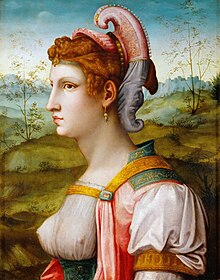Sibyl
Tampilan

Sibyl adalah wanita yang bangsa Yunani kuno percayai sebagai orakel. Menurut legenda,[1] sibyl-sibyl awal dinabikan di tempat-tempat suci. Nubuat-nubuat mereka dipengaruhi oleh inspirasi ilahi dari seorang dewa; berawal di Delphi dan Pessinos, dewa-dewa tersebut adalah dewa khthonik. Pada Abad Kuno AKhir, berbagai penulis berupaya untuk membuktikan keberadaan sibyl di Yunani, Italia, Syam, dan Asia Kecil.
Kata sibyl (/ˈsɪbəl/ atau /ˈsɪbɪl/) datang — melalui kata bahasa Prancis Lama sibile dan kata bahasa Latin sibylla — dari kata bahasa Yunani kuno σίβυλλα (sibulla, plural σίβυλλαι sibullai).[2]
Catatan
[sunting | sunting sumber]- ^ Burkert 1985 p 117
- ^ "Sibyl"
 . Oxford English Dictionary (edisi ke-Online). Oxford University Press. Templat:OEDsub
. Oxford English Dictionary (edisi ke-Online). Oxford University Press. Templat:OEDsub
Sumber
[sunting | sunting sumber]- Beyer, Jürgen, 'Sibyllen', "Enzyklopädie des Märchens. Handwörterbuch zur historischen und vergleichenden Erzählforschung", vol. 12 (Berlin & New York, Walter de Gruyter 2007), coll. 625-30
- Bouché-Leclercq, Auguste, Histoire de la divination dans l'Antiquité, I-IV volumes, Paris, 1879-1882.
- Broad, William J., The Oracle: the Lost Secrets and Hidden Message of Ancient Delphi (Penguin Press, 2006).
- Burkert, Walter, Greek Religion (Harvard University Press, 1985) esp. pp 116–18.
- Delcourt, M. L'oracle de Delphes, 1955.
- Encyclopædia Britannica, 1911.
- Fox, Robin Lane, Alexander the Great 1973. Chapter 14 gives the best modern account of Alexander's visit to the oasis at Siwah, with some background material on the Greek conception of Sibyls.
- Goodrich, Norma Lorre, Priestesses, 1990.
- Hale, John R. and others (2003). Questioning the Delphic Oracle. Retrieved Jan. 7, 2005.
- Hindrew, Vivian, The Sibyls: The First Prophetess of Mami (Wata) MWHS, 2007)
- Jeanmaire, H. La Sibylle et la retour de l'âge d'or, 1939.
- Lanciani, Rofolfo, Pagan and Christian Rome, 1896, ch. 1 on-line
- Lactantius, Divine Institutions Book I, ch. vi (e-text, in English)
- Maass, E., De Sibyllarum Indicibus, Berlin, 1879.
- Parke, Herbert William, History of the Delphic Oracle, 1939.
- Parke, Herbert William, Sibyls and Sibylline Prophecy, 1988.
- Pausanias, Description of Greece, ed. and translated by Sir James Frazer, 1913 edition. Cf. v.5
- Peck, Harry Thurston, Harper's Dictionary of Classical Antiquity, 1898. [1]
- Pitt-Kethley, Fiona, Journeys to the Underworld, 1988
- Potter, David Stone, [2] Diarsipkan 2009-02-13 di Wayback Machine., Prophecy and history in the crisis of the Roman Empire: a historical commentary on the Thirteenth Sibylline Oracle, 1990. Cf. Chapter 3. review of book Diarsipkan 1999-04-27 di Wayback Machine.
- Potter, David Stone, Prophets and Emperors. Human and Divine Authority from Augustus to Theodosius, Cambridge, MA: Harvard University Press, 1994. review of book
- Smith, William, Dictionary of Greek and Roman Biography and Mythology, 1870, article on Sibylla, [3] Diarsipkan 2006-08-24 di Wayback Machine.
- West, Martin Litchfield, The Orphic Poems, Oxford, 1983.
Pranala luar
[sunting | sunting sumber]Wikimedia Commons memiliki media mengenai Sibyls.
Sibyl klasik
[sunting | sunting sumber]- John Burnet Early Greek Philosophy, 63., 64. brief analysis, 65. the fragments Diarsipkan 1999-02-09 di Archive.is
- Jewish Encyclopedia: Sibyl.
- The Sibyls Diarsipkan 2005-04-03 di Wayback Machine.
Musik
[sunting | sunting sumber]- El Cant de la Sibil-la / Mallorca / València (1400-1560) - Montserrat Figueras, Jordi Savall - La Capella Reial de Catalunya - Alia Vox 9806
- El Cant de la Sibil-la / Catalunya - Montserrat Figueras, Jordi Savall - La Capella Reial de Catalunya - Alia Vox AVSA9879
- The Song of the Sybil - Track 4 - 3:45 - Aion (1990) - Dead Can Dance Diarsipkan 2015-10-27 di Wayback Machine.
Sibyl yang di-Kristen-kan pada Abad Pertengahan
[sunting | sunting sumber]Pencitraan sibyl modern
[sunting | sunting sumber]- A sardonic sequence of 'Twelve Sibyls', accompanied by the artist Leonard Baskin's woodcuts, revisits Sibyls and Others (1980). Ruth Fainlight has written dozens of poems about these ambiguous figures, bridging religion, classical and Biblical settings, femininity and modernity. One of them concludes: 'I am no more conscious of the prophecies / than I can understand the language of birds /…let the simple folk praise you, / keep you safe as a caged bird, / and call you a sibyl'.
- Pjetër Bogdani, "The Songs of the Ten Sibyls" modern poetry, translated from Albanian
- T.S. Eliot's The Waste Land is prefaced by a quote from Petronius' Satyricon (1st century AD) The passage translates roughly as "I saw with my own eyes the Sibyl at Cumae hanging in a jar, and when the boys said to her 'Sibyl, what do you want?' that one replied 'I want to die'.
- The SIBYLS beamline at the Advanced Light Source in Berkeley, CA.
- Sibyl is the oracular protagonist in an independent movie, currently in pre-production (2014). She foresees the destruction of the Colosseum as a plane full of nuclear waste is returned to its rightful owners, but can she prevent it from happening? [4] Diarsipkan 2014-08-19 di Wayback Machine.
